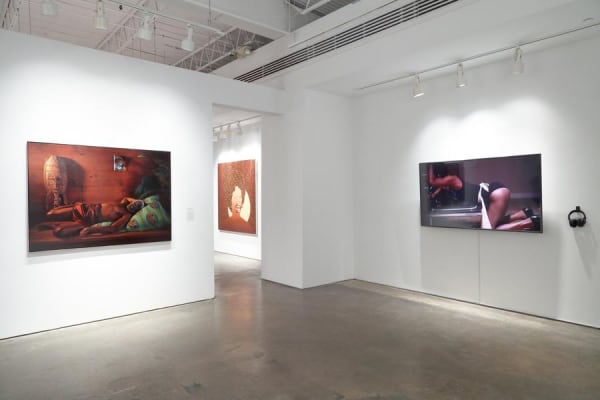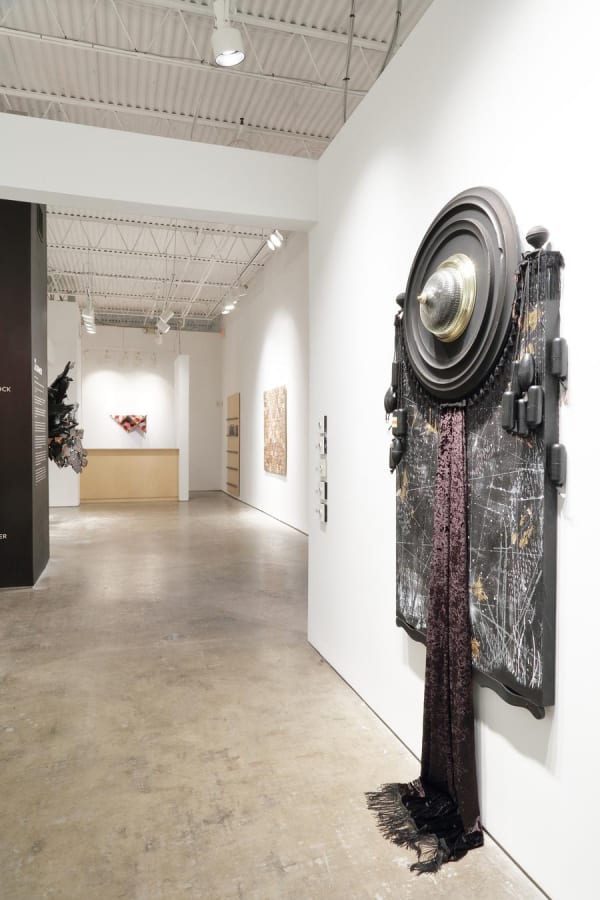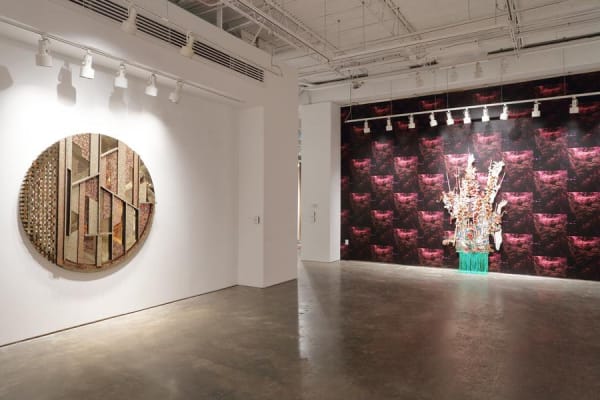Co-curated by Donovan Johnson and Seph Rodney, the Johnson Lowe Gallery’s magnetic group exhibition of twenty-nine Atlanta-based, American, and/or international Black artists such as Renee Stout, Sanford Biggers, Masud Olufani, Leonardo Drew, Devan Shimoyama, and others delivered a name which was more than apse. From the minute we encounter the gallery’s austere white walls, the show artfully pulls us to Black abstraction to figuration in painting, sculpture, and video in a continuous semi-circular rhythm and pattern. One attempts to decipher each artist’s hieroglyphic and heated vision of Blackness in America today.
While each artist powerfully addressed Black identity in meaningful ways, some simply struck Nubian gold. In Thornton Dial’s 1994 massive mixed-media wall piece, The Dreamer: The Hills & The Mountains, the canvas converts into inadvertent monumental relief sculpture with its mix of industrial scraps, oil, enamel, spray paint, tin, roots, and tire tread on wood, penetrating space and time with a breathtaking dexterity one imagines his hands mastered during his metalworker employment at the Pullman Standard Railcar company. We also envision and hear the clanging sounds of metal clashing amidst trains, cars, goods, and human passenger movement in this work, unable to fully absorb the entirety of his metallurgic passions in one sitting. The materials transport us to an “old dirty South”, one mired in racial segregation, poverty, and rustic humidity, but also move us towards a contemporary, optimistic South; one where Dial’s work is honored and appreciated in this gallery without any whitewash of its clamor for racial, social, and economic justice. Dial’s sculptural Dreamer does not leave us in Emelle, Alabama. He reaches the cosmopolitan capital of Atlanta, and the shifty shores of Ahmaud Arbery’s Glynn County, Georgia, compelling us to confront the horrors and legacy of slavery and racism in the deep South at each stop, while providing us glimmers of shiny mineral embedded in a deep brown and gray rust.
Interdisciplinary and Afro-Caribbean artist; Shervone Neckles addresses Carnival, an annual custom of beauty, revelry, and profound historical links to Black emancipation in three works entitled, Touched, Bush Woman, and Germinate from left to right. It is a festival celebrated throughout the Caribbean and enjoyed by members of the diaspora all over the world. Neckles’ ancestral Grenada remains a steady communicative totem in many of her works. By mixing past and present, Neckles allows the ancestral spirits to enjoy the present fruits of their labor with their descendants in real time. Arranged in a triptych formation, Neckles’ three separate works incorporate collage, applique, and embroidery in horizontal and circular fashion. Her materials and methods pay homage to her family’s seamstresses, who diligently supported their spouses and children during tough times as immigrants in America, while she simultaneously weaves us into a fabric of joyous black gold of a different skin. The enticing feminine Black figure recalls the black-oiled, darkly painted, and mud-covered skins of sensuous and muscular scantily clad Jab-Jab or Jab-molassie J’ouvert and carnival dancers.
We are stitched between past, present, and future, united in an ecstasy of rich reds and dark blacks, dotted with white and colorful beads and the spirits of Africa. The Black body wields its imprint in Neckles’ works in unexpected ways. The contrasting dark outline and figures are not blocky, imposing figures, nor does the black figure engage with the black serpent in a menacing way. Instead, nature, bodies, and spirit float ever closer to diasporic seas of desire, freedom, and festival abandon.
Lastly, trans-disciplinary and Jamaican-born artist Cosmo Whyte utilizes charcoal, gold leaf, and paint on paper to simultaneously satisfy and obscure our insistent gaze and troubled societal interaction with the black male figure. Our political, religious, and moral judgments are obfuscated by his ceaseless diagonal floral patterns cascading from the upper right of the canvas to the entire bottom half of the canvas. The artist has placed the black figure on the correct side of the canvas, and on the right side of history, while he smoothly drinks from a bottle of unknown liquid. We want to know what the subject is drinking and its potency in order to make our assumptions of his vices, pastimes, class, or taste. Its charcoal grays prevent us from reading its label and content. The viewer must remain in a liquid limbo of uncertainty, almost oblivious to the fact that we were freely invited to participate in the handsome model’s treasured moments of peace and self-reflection.
In a city which is 48% Black, both curators highlight a different path taken by the Black artists in this show with oil paint, textiles, fabrics, beads, and traditional chiaroscuro. These works shine in ways art historian Krista Thompson could not have predicted.1 They are not predicated on “bling” and hip-hop’s material culture, wealth and excess, but mine black current corporeal identity and its earthly legacies of colonialism, slavery, and suffering into a burnished and fresh South.
Shazam!
- Black Adam
- Black Adam
-
Notes:
6.17.23
Notes:
- Thompson, Krista. "The Sound of Light: Reflections in Art History in the Visual Culture of Hip Hop." The Art Bulletin, 91:4 (December 2009), 481-505.
6.17.23
Danelle Bernten (she/her) is an art historian residing in Tallahassee, Florida. Her primary interest focuses on African-American Art and the arts of the African diaspora. Some of her writings have been published in the Journal of Art Crime, Still Point Arts Quarterly, Number Inc., Steam Ticket (University of Wisconsin-La Crosse).
May 4, 2023











